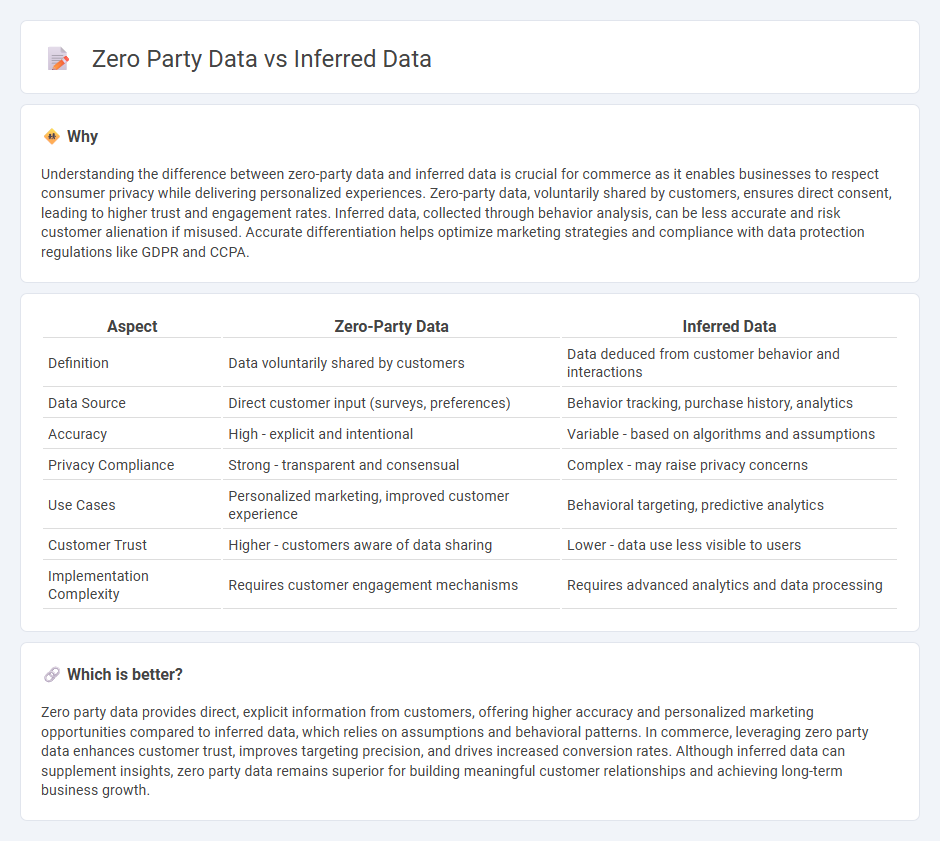
Zero-party data consists of information that customers proactively share with businesses, offering precise insights into preferences and intentions. Inferred data, however, is gathered indirectly through user behavior analysis and predictive algorithms, which may lack explicit consent or accuracy. Explore these data strategies to enhance personalized commerce experiences effectively.
Why it is important
Understanding the difference between zero-party data and inferred data is crucial for commerce as it enables businesses to respect consumer privacy while delivering personalized experiences. Zero-party data, voluntarily shared by customers, ensures direct consent, leading to higher trust and engagement rates. Inferred data, collected through behavior analysis, can be less accurate and risk customer alienation if misused. Accurate differentiation helps optimize marketing strategies and compliance with data protection regulations like GDPR and CCPA.
Comparison Table
| Aspect | Zero-Party Data | Inferred Data |
|---|---|---|
| Definition | Data voluntarily shared by customers | Data deduced from customer behavior and interactions |
| Data Source | Direct customer input (surveys, preferences) | Behavior tracking, purchase history, analytics |
| Accuracy | High - explicit and intentional | Variable - based on algorithms and assumptions |
| Privacy Compliance | Strong - transparent and consensual | Complex - may raise privacy concerns |
| Use Cases | Personalized marketing, improved customer experience | Behavioral targeting, predictive analytics |
| Customer Trust | Higher - customers aware of data sharing | Lower - data use less visible to users |
| Implementation Complexity | Requires customer engagement mechanisms | Requires advanced analytics and data processing |
Which is better?
Zero party data provides direct, explicit information from customers, offering higher accuracy and personalized marketing opportunities compared to inferred data, which relies on assumptions and behavioral patterns. In commerce, leveraging zero party data enhances customer trust, improves targeting precision, and drives increased conversion rates. Although inferred data can supplement insights, zero party data remains superior for building meaningful customer relationships and achieving long-term business growth.
Connection
Zero party data, collected directly from customers through surveys or preferences, offers precise insights into consumer intent and preferences. Inferred data complements this by analyzing behavioral patterns and interactions to predict additional customer attributes. Together, these data types enhance personalized commerce strategies by combining explicit consented information with predictive analytics.
Key Terms
Consent
Inferred data derives from analyzing user behavior and third-party sources without direct user consent, often raising privacy concerns under regulations like GDPR and CCPA. Zero party data is explicitly shared by users, ensuring transparent consent and higher accuracy in personalization strategies. Explore how prioritizing consent with zero party data can enhance user trust and compliance.
Data Source
Inferred data is collected by analyzing user behavior, interactions, and patterns from third-party sources or indirect tracking methods, offering insights without direct user input. Zero-party data, however, is explicitly shared by the user through surveys, preferences, or direct communication, ensuring higher accuracy and trustworthiness. Explore how selecting the right data source impacts personalization strategies and customer relationships.
Personalization
Inferred data leverages algorithms to predict user preferences based on behavior patterns and indirect signals, enhancing personalization by anticipating needs without explicit input. Zero-party data directly captures users' preferences, intentions, and consent, providing highly accurate and privacy-compliant personalization opportunities. Discover how integrating both data types can optimize personalized user experiences.
Source and External Links
What Is Inferred Data and Why Is It Important? - Inferred data is generated by analyzing user data collected directly or indirectly to deduce characteristics or predict behaviors of data subjects, and its classification impacts privacy and intellectual property considerations.
Biometrically-Inferred Data (BID) - X Reality Safety Intelligence (XRSI) - Biometrically-inferred data consists of datasets derived from behavioral, physical, and psychological biometric identification techniques such as facial recognition, iris scanning, voice recognition, and gait analysis.
Inferred Vs Observed Data - ExchangeWire.com - Inferred data involves predictions based on observed data and can reduce targeting accuracy if it is based on other inferences rather than direct observations, making data validation crucial for reliable use.
 dowidth.com
dowidth.com